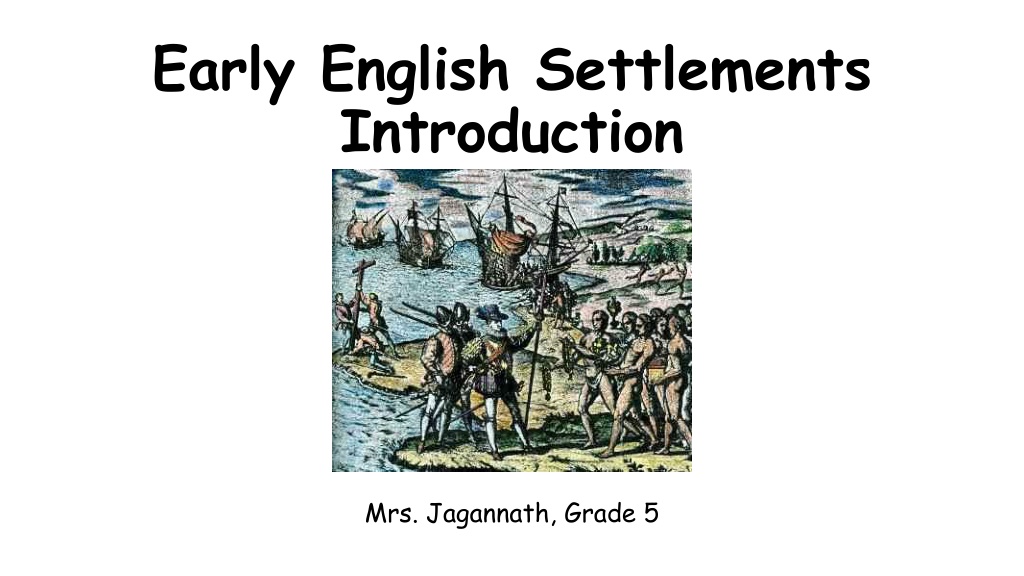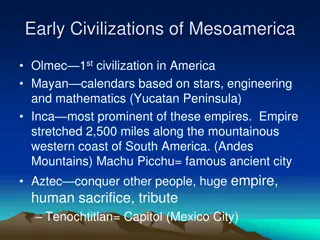Early English Settlements in North America: A Historical Overview
The early 1600s marked the influx of European immigrants to North America, laying the foundation for a new civilization. Despite hardships during the journey and economic difficulties in England, colonists sought political freedom, religious liberty, and better opportunities in the New World. Friendly interactions with Native Americans and access to abundant natural resources were crucial for the survival and prosperity of the early English settlements.
Download Presentation

Please find below an Image/Link to download the presentation.
The content on the website is provided AS IS for your information and personal use only. It may not be sold, licensed, or shared on other websites without obtaining consent from the author. Download presentation by click this link. If you encounter any issues during the download, it is possible that the publisher has removed the file from their server.
E N D
Presentation Transcript
Early English Settlements Introduction Mrs. Jagannath, Grade 5
The early 1600s saw the beginning of a great tide of immigration from Europe to North America. Spanning more than three centuries, this movement grew from a trickle of a few hundred English colonists to a flood of millions of newcomers. Encouraged by powerful and diverse motivations, they built a new civilization on the northern part of the continent.
The first English immigrants to what is now the United States crossed the Atlantic long after thriving Spanish colonies had been established in Mexico, the West Indies, and South America. Like all early travelers to the New World, they came in small, overcrowded ships. During their six-to 12-week voyages, they lived on meagerrations. Many died of disease, ships were often battered by storms, and some were lost at sea.
Most European immigrants left their homelands to escape political oppression, to seek the freedom to practice their religion, and to find opportunities denied them at home. Between 1620 and 1635, economic difficulties swept England. Many people could not find work. Even skilled artisans could earn little more than a bare living. Poor crop yields added to the distress.
Turn to your Partner 1. What was the journey to North America like for early English colonists? 2. What was happening in England between 1620 and 1635? 3. What were the three main reasons colonists wanted to leave England and come to America?
The colonists' first glimpse of the new land was a scene of dense woods. The settlers might not have survived had it not been for the help of friendly Indians, who taught them how to grow native plants pumpkin, squash, beans, and corn. In addition, the vast, virgin forests, extending nearly 2,100 kilometers along the Eastern seaboard, proved a rich source of game and firewood. They also provided abundant raw materials used to build houses, furniture, ships, and profitable items for export.
Although the new continent was remarkably filled with nature, trade with Europe was vital for items the settlers could not produce. The coast served the immigrants well. The whole length of shore provided many inlets and harbors. Only two areas North Carolina and southern New Jersey lacked harbors for ocean-going vessels.
Majestic rivers linked lands between the coast and the Appalachian Mountains with the sea. Only one river, however, the St. Lawrence dominated by the French in Canada offered a water passage to the Great Lakes and the heart of the continent. Dense forests, the resistance of some Indian tribes, and the barrier of the Appalachian Mountains discouraged settlement beyond the coastal plain. Only trappers and traders ventured into the wilderness. For the first hundred years the colonists built their settlements compactly along the coast.
Turn to your Partner 4. How did Native Americans help early English Colonists? 5. Why did early English colonists stick close by the Atlantic Coast?
The journey required careful planning and management, as well as considerable expense and risk. Settlers had to be transported nearly 5,000 kilometers across the sea. They needed utensils, clothing, seed, tools, building materials, livestock, arms, and ammunition. The immigration from England was not directly sponsored by the government but by private groups of individuals whose chief motive was profit.

























